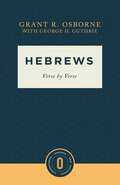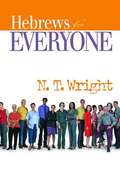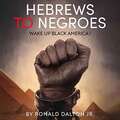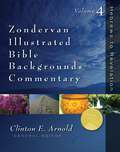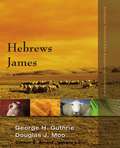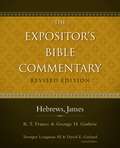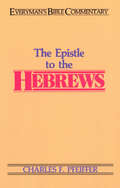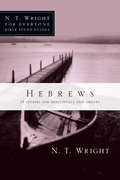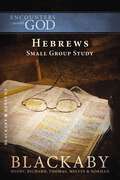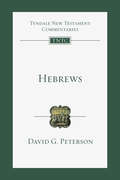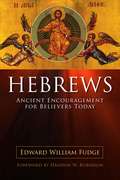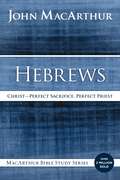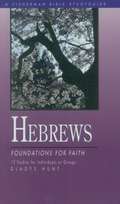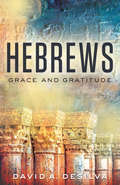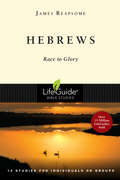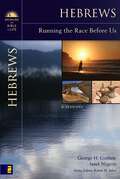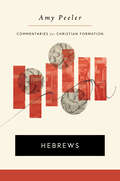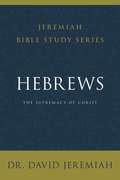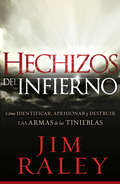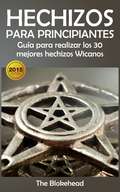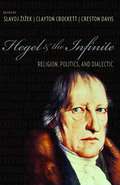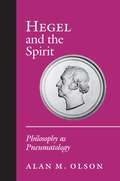- Table View
- List View
Hebrews Through New Eyes: Christ and His Rivals
by Douglas WilsonIf we want to study our Bibles under the pleasure of God, we should not bring to the text certain a priori assumptions about what God can and cannot tell us, as well as assumptions about the ways in which he is permitted to tell us. We must learn from Scripture how to handle Scripture. And so this is an area where we must be willing to grow. The imagination must not be flighty--it must be disciplined by the Scriptures and by the mind of Christ. And as we are taught by Scripture, we should not be surprised when we learn some things we were not expecting to learn.
Hebrews Verse by Verse (Osborne New Testament Commentaries)
by Grant R. OsborneThe letter to the Hebrews is unique in the New Testament for its focus on the priesthood of Jesus and its interaction with the Old Testament. But beyond this deep theology, Hebrews is a practical book that addresses the very real challenges believers face when life gets difficult. In Hebrews Verse by Verse, the late Grant R. Osborne, with George H. Guthrie, shows readers how this beautifully crafted letter encourages believers to endure in faithfulness to Jesus. By using Scripture and theology to lay the foundation for these exhortations, the central message of Hebrews continues to be relevant for the church today. Osborne's commentary delves into the grand implications of Christ's identity and its importance for our spiritual lives.
Hebrews for Everyone
by N. T. WrightWriting in an approachable and anecdotal style, Tom Wright helps us to find our way around the letter to the Hebrews, one of the most challenging writings in the New Testament. He acknowledges that people often find it difficult, because some of the ideas it contains are strange to us. Yet, like meeting a new friend, Wright helps us to find Hebrews full of interest and delight, with a powerful message that comes home to the church of today and tomorrow just as much as it did to the church of yesterday. Tom Wright has undertaken a tremendous task: to provide guides to all the books of the New Testament, and to include in them his own translation of the entire text. Each short passage is followed by a highly readable discussion with background information, useful explanations and suggestions, and thoughts as to how the text can be relevant to our lives today. A glossary is included at the back of the book. The series is suitable for group study, personal study, or daily devotions.
Hebrews to Negroes: Wake Up Black America!
by Ronald Dalton JrSince the time the European and Arab slave traders stepped foot into Africa, blacks have been told lies about their heritage. This was all by Satan's design, for he is the father of lies. Since biblical times, there has been a satanic agenda to destroy God's chosen people. This agenda still exists today and is carried on by man in many forms. Satan knows who God's chosen people are, but for centuries, we have been ignorant to this knowledge, even though it's been right in front of our face. After many years of research, the time has finally come for all black people to know the truth. <p><p> Inside Hebrews to Negroes, you will find the answers to all the burning questions you have wanted ask your parents, teachers, and pastors for years. It has been said that the mind has a strong drive to correct itself over a period of time if it can touch some substantial original historical base about itself. This time period is ending, and the truth is being exposed! Is this a sign of the End Times? <p><p> The Bible says that in the last days, knowledge will increase. It also says, "In the last days, saith God, I will pour out of my Spirit upon all flesh: and your sons and your daughters shall prophesy, and your young men shall see visions, and your old men shall dream dreams." <p><p> Knowledge is the truth, and Satan's time is running out. Don't be left behind. Find out what's really going on behind the scenes as it relates to Black America then and now. Afterward, you be the judge as to who God's chosen people really are, and who Satan's army is really after. At the end of this audiobook, I guarantee you won't regret it.
Hebrews to Revelation: Volume Four (Zondervan Illustrated Bible Backgrounds Commentary)
by Clinton E. ArnoldDiscover · How the springs at Hierapolis help us understand why Jesus described the church at Laodicea as “lukewarm” · The background and circumstances of certificates of divorce in Judaism · How Jewish dietary laws provided a powerful metaphor for God’s acceptance of the Gentiles Brimming with lavish, full-color photos and graphics, the Zondervan Illustrated Bible Backgrounds Commentary walks you verse by verse through all the books of the New Testament. It’s like slipping on a set of glasses that lets you read the Bible through the eyes of a first-century reader! Discoveries await you that will snap the world of the New Testament into gripping immediacy. Things that seem mystifying, puzzling, or obscure will take on tremendous meaning when you view them in their ancient context. You’ll deepen your understanding of the teachings of Jesus. You’ll discover the close, sometimes startling interplay between God’s kingdom and the practical affairs of the church. Best of all, you’ll gain a deepened awareness of the Bible’s relevance for your life. Written in a clear, engaging style, this beautiful set provides a new and accessible approach that more technical expository and exegetical commentaries don’t offer. It features: · Commentary based on relevant papyri, inscriptions, archaeological discoveries, and studies of Judaism, Roman culture, Hellenism, and other features of the world of the New Testament · Hundreds of full-color photographs, color illustrations, and line drawings · Copious maps, charts, and timelines · Sidebar articles and insights · “Reflections” on the Bible’s relevance for 21st-century living Written by leading evangelical contributors: Clinton E. Arnold (Ph.D., University of Aberdeen), General Editor S. M. Baugh (Ph.D., University of California, Irvine) Peter H. Davids (Ph.D., University of Manchester) David E. Garland (Ph.D., Southern Baptist Theological Seminary) David W. J. Gill (D.Phil., University of Oxford) George H. Guthrie (Ph.D., Southwestern Baptist Theological Seminary) Moyer V. Hubbard (D.Phil., University of Oxford) Andreas J. Köstenberger (Ph.D., Trinity Evangelical Divinity School) Ralph P. Martin (Ph.D., University of London, King’s College) Douglas J. Moo (Ph.D., University of St. Andrews) Mark L. Strauss (Ph.D., University of Aberdeen) Frank Thielman (Ph.D., Duke University) Jeffrey A. D. Weima (Ph.D., University of Toronto) Michael J. Wilkins (Ph.D., Fuller Theological Seminary) Mark W. Wilson (D.Litt. et Phil., University of South Africa) Julie L. Wu (Ph.D., Fuller Theological Seminary) Robert W. Yarbrough (Ph.D., University of Aberdeen) Zondervan Illustrated Bible Backgrounds Commentary includes Matthew, Mark, Luke (Volume One) John, Acts (Volume Two) Romans to Philemon (Volume Three) Hebrews to Revelation (Volume Four)
Hebrews, James
by Douglas J. Moo Clinton E. Arnold George H. GuthrieDiscover: ·How the springs at Hierapolis help us understand why Jesus described the church at Laodicea as “lukewarm” ·The background and circumstances of certificates of divorce in Judaism ·How Jewish dietary laws provided a powerful metaphor for God’s acceptance of the Gentiles Brimming with photos and graphics, the Zondervan Illustrated Bible Backgrounds Commentary walks you verse by verse through all the books of the New Testament. It’s like slipping on a set of glasses that lets you read the Bible through the eyes of a first-century reader! Discoveries await you that will snap the world of the New Testament into gripping immediacy. Things that seem mystifying, puzzling, or obscure will take on tremendous meaning when you view them in their ancient context. You’ll deepen your understanding of the teachings of Jesus. You’ll discover the close, sometimes startling interplay between God’s kingdom and the practical affairs of the church. Best of all, you’ll gain a deepened awareness of the Bible’s relevance for your life. Written in a clear, engaging style, this beautiful set provides a new and accessible approach that more technical expository and exegetical commentaries don’t offer. It features: ·Commentary based on relevant papyri, inscriptions, archaeological discoveries, and studies of Judaism, Roman culture, Hellenism, and other features of the world of the New Testament ·Hundreds of photographs, illustrations, and line drawings ·Copious maps, charts, and timelines·Sidebar articles and insights ·“Reflections” on the Bible’s relevance for 21st-century livingWritten by leading evangelical contributors: Clinton E. Arnold (Ph.D., University of Aberdeen), General Editor S. M. Baugh (Ph.D., University of California, Irvine) Peter H. Davids (Ph.D., University of Manchester) David E. Garland (Ph.D., Southern Baptist Theological Seminary) David W. J. Gill (D.Phil., University of Oxford) George H. Guthrie (Ph.D., Southwestern Baptist Theological Seminary) Moyer V. Hubbard (D.Phil., University of Oxford) Andreas J. Köstenberger (Ph.D., Trinity Evangelical Divinity School) Ralph P. Martin (Ph.D., University of London, King’s College) Douglas J. Moo (Ph.D., University of St. Andrews) Mark L. Strauss (Ph.D., University of Aberdeen) Frank Thielman (Ph.D., Duke University) Jeffrey A. D. Weima (Ph.D., University of Toronto) Michael J. Wilkins (Ph.D., Fuller Theological Seminary) Mark W. Wilson (D.Litt. et Phil., University of South Africa) Julie L. Wu (Ph.D., Fuller Theological Seminary) Robert W. Yarbrough (Ph.D., University of Aberdeen)
Hebrews, James
by Tremper Longman III David E. Garland George H. GuthrieContinuing a Gold Medallion Award-winning legacy, this completely revised edition of The Expositor’s Bible Commentary series puts world-class biblical scholarship in your hands. Based on the original twelve-volume set that has become a staple in college and seminary libraries and pastors’ studies worldwide, this new thirteen-volume edition marshals the most current evangelical scholarship and resources. The thoroughly revised features consist of: • Comprehensive introductions • Short and precise bibliographies • Detailed outlines • Insightful expositions of passages and verses • Overviews of sections of Scripture to illuminate the big picture • Occasional reflections to give more detail on important issues • Notes on textual questions and special problems, placed close to the texts in question • Transliterations and translations of Hebrew and Greek words, enabling readers to understand even the more technical notes • A balanced and respectful approach toward marked differences of opinion
Hebrews- Everyman's Bible Commentary (Everyman's Bible Commentaries)
by Charles PfeifferThe emphasis of Hebrews was born out of the concern of the writer for those who had been true to Christ in the past but who were now wavering. Signs of defection from the faith brought both a warning against apostasy and a fervent exhortation to press onward to spiritual maturity. The epistle argues that the death of Christ renders obsolete the Old Testament sacrificial system and presupposes thorough familiarity with that system by those to whom the epistle is addressed. This strong appeal to the Old Testament Scriptures opens up new avenues of thought for appreciation for the unity of the two Testaments.Dr. Pfeiffer's helpful commentary on this profound New Testament book systematically covers each passage while singling out difficult phrases and verses for special attention. This Everyman's Bible Commentary is based upon the scriptural text as found in the King James Version.
Hebrews: 13 Studies For Individuals Or Groups (N. T. Wright for Everyone Bible Study Guides)
by N. T. Wright Patty PellFor many Jewish Christians of the first century, living in the light of the gospel was challenging. Having accepted Jesus as the long-awaited Messiah, they were regarded by still-skeptical family, friends and neighbors as dangerous, misguided and even disloyal to all that God had said earlier on. The letter to the Hebrews was written to show that you can't go back to an earlier stage of God's purposes but must press on eagerly to the one that is yet to come. In these studies by Tom Wright we find encouragement and assurance that pressing on, even in the face of such close and constant pressure to fall back, is its own reward.
Hebrews: A Blackaby Bible Study Series (Encounters with God)
by Norman Blackaby Henry Blackaby Richard Blackaby Melvin Blackaby Tom BlackabyLet five premier teachers of God's Word lead you to a closer, more intimate understanding of God's message to His people. Intended as companions to the Blackaby Study Bible, these guides also stand alone as a complete study of a book of the Bible. The lessons include: Leader's Notes 7 studies based on reference materials included in the Blackaby Study Bible An explanation and interpretation of Scripture A story that illustrates the passage in focus Other Bible verses related to the theme Questions for reflection Suggestions for application in everyday life.
Hebrews: An Introduction and Commentary (Tyndale New Testament Commentaries #Volume 15)
by David G. PetersonThe letter to the Hebrews provides an amazing combination of warnings and assurances to encourage Christians to persevere in faith, hope, and love. The basis for this is a profound reflection on the person and work of Christ, viewed as the fulfilment of Old Testament Scripture. In this Tyndale commentary, David G. Peterson shows how the author expounds the implications of the gospel with pastoral insight and sensitivity, producing a "word of exhortation" that reaches across the centuries to speak to our lives today. The Tyndale Commentaries are designed to help the reader of the Bible understand what the text says and what it means. The Introduction to each book gives a concise but thorough treatment of its authorship, date, original setting, and purpose. Following a structural Analysis, the Commentary takes the book section by section, drawing out its main themes, and also comments on individual verses and problems of interpretation. Additional Notes provide fuller discussion of particular difficulties. In the new New Testament volumes, the commentary on each section of the text is structured under three headings: Context, Comment, and Theology. The goal is to explain the true meaning of the Bible and make its message plain.
Hebrews: Ancient Encouragement for Believers Today
by Edward William FudgeIntended for preachers, university and seminary students and adult Bible class teachers, Hebrews: Ancient Encouragement for Believers Today is a "bridge" commentary -- delivering the best insights of contemporary scholarship in understandable, non-technical language. Edward William Fudge shows that the author of Hebrews used four Psalms as a framework to re-tell the story of Jesus to a disheartened audience that was tempted to walk away. The same structure and intense focus on Jesus permeates and empowers this narrative commentary, bringing fresh encouragement to believers today.
Hebrews: Christ: Perfect Sacrifice, Perfect Priest (MacArthur Bible Studies)
by John F. MacArthurPastor John MacArthur will take you through the book of Hebrews, passage by passage, so that you can better understand the author's message, the cultural context, and the perfect sufficiency of Christ.The early Jewish believers had come from a background of legalism and works. When God came to earth in human flesh as the New Covenant, these believers discovered the freedom they could have in Jesus and the relationship they could enjoy with Him. Yet in the midst of persecution and rejection, they were often tempted to hold on to the former symbols, rituals, and traditions grounded in the requirements of the Old Covenant.The unknown author of Hebrews sought to address this problem by contrasting the Old and New Covenants, brilliantly showing that Christ is higher than any Old Testament character, priest, ritual, or sacrifice. Because of Jesus' life, death, and resurrection, He is the perfect sacrifice and our own High Priest. And He has given all believers unfettered access to God!—ABOUT THE SERIES—The MacArthur Bible Study series is designed to help you study the Word of God with guidance from widely respected pastor and author John MacArthur. Each guide provides intriguing examinations of the whole of Scripture by examining its parts and incorporates:Extensive, but straight-forward commentary on the text.Detailed observations on overriding themes, timelines, history, and context.Word and phrase studies to help you unlock the broader meaning and apply it to your life.Probing, interactive questions with plenty of space to write down your response and thoughts.
Hebrews: Foundations for Faith (Fisherman Bible Studyguide Series)
by Gladys HuntFind Reality in Jesus ChristGod's people in the Old Testament experienced only shadows of the truth about sin and salvation; their perception was dim and incomplete. But Jesus, with his once-for-all perfect sacrifice, brings the blurred shadows into focus and allows us crystal-clear understanding of God's reality. In showing us the way to please God, the writer to the Hebrews contrasts Old Testament sacrifices with the abundant, life-changing grace available in Jesus Christ. 13 sessions for individuals or groupsFisherman Bible Studyguides include: . Penetrating questions that generate discussion. Flexible format for group or individual needs. Helpful leader's notes. Emphasis on daily application of Bible truthFrom the Trade Paperback edition.
Hebrews: Grace and Gratitude (Hebrews)
by David A. deSilvaThe Book of Hebrews helps us see the connection between God’s grace in our lives and the call to invest ourselves in God’s mission in the world. In doing so, we express gratitude for the salvation we have received and respond to God’s grace by being faithful to the One who delivers us.In Hebrews: Grace and Gratitude, author and New Testament scholar David deSilva takes you through a study of Hebrews, tracing the themes of grace and gratitude through this unique New Testament book. In the Book of Hebrews, you will discover a bold perspective on who Jesus is and what he has done, as well as a powerful reflection on the meaning and significance of his death and resurrection in light of the Old Testament. As you read and study this letter, you will receive a deeper appreciation for the salvation we have received through Christ and hear afresh God’s call to a life of gratitude and faithfulness.Additional components for a six-week study include a DVD featuring David deSilva and a comprehensive Leader Guide.
Hebrews: Race to Glory (LifeGuide Bible Studies)
by James Reapsome"What's the use?" At times of frustration or disappointment, it is tempting to ask this question. You work and work to grow to Christian maturity, but you seem to get nowhere—repeating your mistakes, neglecting your commitments, losing your motivation. The original readers of Hebrews felt the same way! Yet the writer of this New Testament letter cheers for them to stay on track and never quit, so they can reach the finish line by the power of Jesus Christ. As James Reapsome leads you through thirteen LifeGuide Bible studies in Hebrews, he offers you—and all of today's faith-weary Christians—the encouragement you need to stay in the faith-race. This LifeGuide Bible Study in IVP's revised format features questions for starting group discussions and for meeting God in personal reflection, as well as a new "Now or Later" section following each session to help you act on what you learn. For over three decades LifeGuide Bible Studies have provided solid biblical content and raised thought-provoking questions—making for a one-of-a-kind Bible study experience for individuals and groups. This series has more than 130 titles on Old and New Testament books, character studies, and topical studies. PDF download with a single-user license; available from InterVarsity Press and other resellers.
Hebrews: Running the Race Before Us (Bringing the Bible to Life)
by Karen H. Jobes Janet Nygren George H. GuthrieA series of Bible study guides following the format and content of the NIV Application Commentaries Series. Each study looks at the original meaning, bridging contexts, and contemporary significance of the text, and offers small group participants a better understanding and relevant application of the biblical material to their daily lives.
Hebrews: The Family Of God In The Epistle To The Hebrews (Commentaries for Christian Formation (CCF))
by Amy PeelerHow can the Letter to the Hebrews help Christians grow in their faith? The Letter to the Hebrews tells us that God is trustworthy—that we can trust in Jesus&’s defeat of death to lead us to eternal life. Complicating this crucial message, the letter&’s enigmatic origins, dense intertextuality, and complex theological import can present challenges to believers wrestling with the text today. Amy Peeler opens up Hebrews for Christians seeking to understand God in this learned and pastoral volume of Commentaries for Christian Formation. Her fresh translation and detailed commentary offer insights into Christology, the relationship between Judaism and Christianity, and the letter&’s canonical resonances. She pays special attention to how the text approaches redemption, providing consolation for the anxious and correction for the presumptuous. Peeler explains the letter&’s original context while remaining focused on its relevance to Christian communities today. Pastors and lay readers alike will learn how Hebrews helps them know, trust, and love God more deeply.
Hebrews: The Supremacy of Christ (Jeremiah Bible Study Series)
by Dr. David JeremiahChrist is faithful...Follow Dr. Jeremiah through the book of Hebrews in a chapter-by-chapter study that will help you understand what it meant to the people at the time it was written, and what it means to Christians today. The letter to the Hebrews is powerful account of Christ's supremacy and faithfulness.The unknown author of Hebrews draws on his expansive knowledge of the Old Testament Scripture to reveal how Jesus is superior to anything the old law had to offer—how Jesus accomplished what the old covenant could not by offering himself as the one and perfect sacrifice to atone for the sins of his people.Each of this study's twelve lessons is clearly organized to include:Getting Started: An opening question to introduce you to the lesson.Setting the Stage: A short reflection to explain the context of the study.Exploring the Text: The Scripture reading for the lesson with related study questions.Reviewing the Story: Questions to help you identify key points in the reading.Applying the Message: Questions to help you apply the key ideas to their lives.Reflecting on the Meaning: A closing reflection on the key teachings in the lesson.—ABOUT THE SERIES—The Jeremiah Bible Study Series captures Dr. David Jeremiah's forty-plus years of commitment in teaching the Word of God. In each study, you'll gain insights into the text, identify key stories and themes, and be challenged to apply the truths you uncover to your life. By the end of each study, you'll come away with a clear and memorable understanding of that Bible book.Each study also contains a Leader's Guide.
Hechizos del infierno: Cómo identificar, llevar cautivas y disipar las armas de la oscuridad
by Jim Raley¿Estamos viviendo en un mundo hechizado?Cuando pensamos en hechizos, la imagen que resalta en nuestra mente a menudo tiene más que ver con las fábulas que aprendimos de niños. Una mujer vieja y fea con un sombrero puntiagudo recitando conjuros en un caldero hirviendo. La realidad, sin embargo, es mucho más peligrosa. Una vez que tenga acceso a nuestras vidas, Satanás puede manipular, dominar e intimidar a los cristianos, incluso el más fuerte. Hechizos del infierno se basa en los escritos de Pablo a la iglesia de los Gálatas para traerle una nueva conciencia sobre los hechizos y estrategias de Satanás, demostrándole cómo puede liberarse de la influencia de males tales como: · Espíritus controladores· Maldiciones generacionales· Brujería en el hogarEliminando el sensacionalismo y lo espeluznante de la guerra espiritual, Raley le permite identificar, comprender y romper cualquier hechizo que el diablo quiera lanzar contra su vida, su familia y su propósito.
Hechizos para Principiantes Guía para realizar los 30 mejores hechizos Wicanos
by The BlokeheadQuisiera agradecer y felicitarle por adquirir “La guía de Hechizos: Guía de realización de los 30 hechizos más populares Wicanos para principiantes”. Este libro contiene pasos y estrategias probados sobre como puede realizar los diferentes hechizos Wicanos para ayudar a mejorar su estado de vida actual. Desde impulsar su suerte financiera a hacerle más atractivo en cuanto al amor, hay bastantes maneras en las cuales estos hechizos pueden ser utilizados. De hecho, la intención al utilizarlos juega una parte central cuando se trata de su elaboración.
Hegel and the Infinite: Religion, Politics, and Dialectic
by Slavoj Žižek Creston Davis Clayton CrockettCatherine Malabou, Antonio Negri, John D. Caputo, Bruno Bosteels, Mark C. Taylor, and Slavoj Žižek join seven others--including William Desmond, Katrin Pahl, Adrian Johnston, Edith Wyschogrod, and Thomas A. Lewis--to apply Hegel's thought to twenty-first-century philosophy, politics, and religion. Doing away with claims that the evolution of thought and history is at an end, these thinkers safeguard Hegel's innovations against irrelevance and, importantly, reset the distinction of secular and sacred. These original contributions focus on Hegelian analysis and the transformative value of the philosopher's thought in relation to our current "turn to religion. " Malabou develops Hegel's motif of confession in relation to forgiveness; Negri writes of Hegel's philosophy of right; Caputo reaffirms the radical theology made possible by Hegel; and Bosteels critiques fashionable readings of the philosopher and argues against the reducibility of his dialectic. Taylor reclaims Hegel's absolute as a process of infinite restlessness, and Žižek revisits the religious implications of Hegel's concept of letting go. Mirroring the philosopher's own trajectory, these essays progress dialectically through politics, theology, art, literature, philosophy, and science, traversing cutting-edge theoretical discourse and illuminating the ways in which Hegel inhabits them.
Hegel and the Infinite: Religion, Politics, and Dialectic (Insurrections: Critical Studies in Religion, Politics, and Culture)
by Creston Davis Slavoj Clayton Crockett Eds. iekCatherine Malabou, Antonio Negri, John D. Caputo, Bruno Bosteels, Mark C. Taylor, and Slavoj Zizek join seven others—including William Desmond, Katrin Pahl, Adrian Johnston, Edith Wyschogrod, and Thomas A. Lewis—to apply Hegel's thought to twenty-first-century philosophy, politics, and religion. Doing away with claims that the evolution of thought and history is at an end, these thinkers safeguard Hegel's innovations against irrelevance and, importantly, reset the distinction of secular and sacred.These original contributions focus on Hegelian analysis and the transformative value of the philosopher's thought in relation to our current "turn to religion." Malabou develops Hegel's motif of confession in relation to forgiveness; Negri writes of Hegel's philosophy of right; Caputo reaffirms the radical theology made possible by Hegel; and Bosteels critiques fashionable readings of the philosopher and argues against the reducibility of his dialectic. Taylor reclaims Hegel's absolute as a process of infinite restlessness, and Zizek revisits the religious implications of Hegel's concept of letting go. Mirroring the philosopher's own trajectory, these essays progress dialectically through politics, theology, art, literature, philosophy, and science, traversing cutting-edge theoretical discourse and illuminating the ways in which Hegel inhabits them.
Hegel and the Spirit: Philosophy as Pneumatology
by Alan M. OlsonHegel and the Spirit explores the meaning of Hegel's grand philosophical category, the category of Geist, by way of what Alan Olson terms a pneumatological thesis. Hegel's philosophy of spirit, according to Olson, is a speculative pneumatology that completes what Adolf von Harnack once called the "orphan doctrine" in Christian theology--the doctrine of the Holy Spirit. Olson argues that Hegel's development of philosophy as pneumatology originates out of a deep appreciation of Luther's dialectical understanding of Spirit and that Hegel's doctrine of Spirit is thus deeply interfused with the values of Würtemberg Pietism. Olson further maintains that Hegel's Enzyklopdie is the post-Enlightenment philosophical equivalent of a Trinitätslehre and that his Rechtsphilosophie is an ecclesiology. Thus Hegel and the Spirit demonstrates the truth of Karl Barth's observation that Hegel is the potential Aquinas of Protestantism. Exploring Hegel's philosophy of spirit in historical, cultural, and personal religious context, the book identifies Hegel's relationship with Hölderlin and his response to Hölderlin's madness as key elements in the philosopher's religious and philosophical development, especially with respect to the meaning of transcendence and dialectic.
Hegel versus ‘Inter-Faith Dialogue’
by Andrew ShanksThe term 'inter-faith' is a recent innovation in English that has gained significant traction in the discussion of religious diversity. This volume argues that the concept of faiths in the plural is deeply problematic for Christian theology and proposes a Hegelian alternative to the conventional bureaucratic notion of inter-faith dialogue. Hegel pioneered the systematic study of comparative religion. In line with Hegelian principle, Andrew Shanks identifies faith as an inflection of the will towards perfect truth-as-openness. In relation to other religious traditions, this must involve the practice of a maximum xenophilia, or love for the unfamiliar, understood as a core Christian virtue. Shanks's neo-Hegelian theory recognises the potential for God's work in all religious traditions, which may be seen as divine experiments with human nature. This timely book discusses a wide range of interreligious encounters and will be an essential resource for studies in comparative theology and philosophy of religion.

